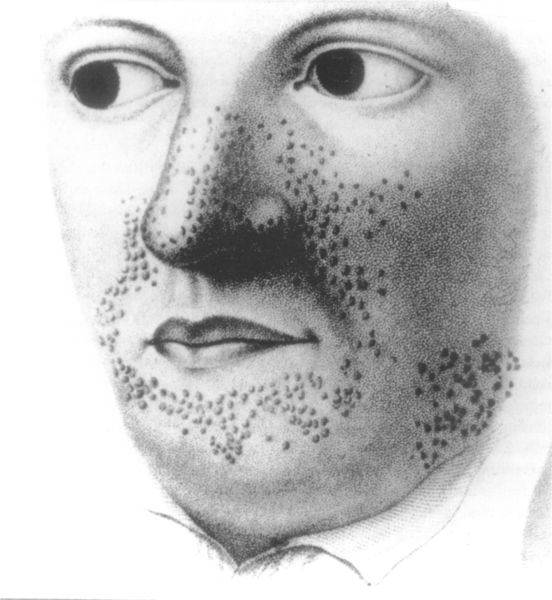Tuberous sclerosis
| Tuberous sclerosis | |
 | |
|---|---|
| Earliest illustration, from Rayer's atlas of skin diseases, 1835. |
|
Tuberous sclerosis Microchapters |
|
Diagnosis |
|---|
|
Treatment |
|
Case Studies |
|
Tuberous sclerosis On the Web |
|
American Roentgen Ray Society Images of Tuberous sclerosis |
For patient information on this page, click here
Editor-In-Chief: C. Michael Gibson, M.S., M.D. [1]; Associate Editor(s)-in-Chief: Raviteja Guddeti, M.B.B.S. [2]
Synonyms and keywords: Tuberous sclerosis complex, TSC, Bourneville disease, Bourneville-Pringle syndrome, epiloia
Imaging
Treatment
Medical therapy
Drug therapy for some of the manifestations of TSC is currently in the developmental stage.[1] For example, a 2008 study found that treatment with rapamycin rescued learning and memory deficits in a mouse model of tuberous sclerosis.[2] Community TSC is a distributed computing project to find drugs to treat TSC.[citation needed] The patients usually have relapse of symptoms in the clinical course. Unless any vital function is affected, life expectancy is good. Majority of patients will require some medications to control symptoms, e.g., anti-epileptics to control seizures. In 2010 everolimus was approved for the treatment of subependymal giant cell astrocytoma.
Other drugs used include:
Facial angiofibromas is a socially embarrassing rash that starts to appear during childhood and can be removed using dermabrasion or laser treatment.
Surgical therapy
Ungual or subungual fibromas may need to be surgically removed if they enlarge or cause bleeding.
References
- ↑ Yates JR (2006). "Tuberous sclerosis". Eur. J. Hum. Genet. 14 (10): 1065–73. doi:10.1038/sj.ejhg.5201625. PMID 16868562. Unknown parameter
|month=ignored (help) - ↑ Ehninger D, Han S, Shilyansky C; et al. (2008). "Reversal of learning deficits in a Tsc2+/− mouse model of tuberous sclerosis". Nat Med. 14 (8): 843–8. doi:10.1038/nm1788. PMC 2664098. PMID 18568033. Lay summary – Science News (23 June 2008).
- ↑ Tsao CY (2009). "Current trends in the treatment of infantile spasms". Neuropsychiatr Dis Treat. 5: 289–99. PMC 2695218. PMID 19557123.
- ↑ Simon D. Shorvon (2010). Handbook of Epilepsy Treatment. John Wiley and Sons. pp. 93–. ISBN 978-1-4051-9818-9. Retrieved 11 October 2010.
Support Groups
- United Kingdom: The Tuberous Sclerosis Association. Awareness month is October.
- United States: Tuberous Sclerosis Alliance. Awareness month is May.
- Canada: Tuberous Sclerosis Canada. Awareness month is May.
- Australasia: Australasian Tuberous Sclerosis Society.
- Brazil: Associação Brasileira de Esclerose Tuberosa (Brazilian Tuberous Sclerosis Association) Template:Pt icon
- Taiwan: Taiwan Tuberous Sclerosis Complex
Template:Phakomatoses and other congenital malformations not elsewhere classified